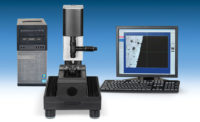Chief among the concerns was how to approach the trend of manufacturing in China. Most of the members agreed that simply hoping the trend would disappear was not realistic. And, with labor costs at nearly one-twelfth of that in the United States, the economic savings were too good for some manufacturers to pass up. Rick Korte, president of Heidenhain Corp. (Schaumburg, IL) said that many of his customers, who build machine tools, were moving manufacturing to China and he had to be there to supply them.
“I wish these parts came from the U.S. But if I can't find it here or it's too expensive, I have to go to offshore sources,“ says Jerry Timmerman of Hatchet Electric Strikes (Phoenix).
Alex Markov of Intel (Phoenix) agreed. “We want to commit to buying U.S. products if we can get the material and price.“
Despite the movement of manufacturing offshore, most of those in attendance believed that higher technology manufacturing, especially that related to medical, automotive and defense, would remain in the United States.
As to prove that point, most of those who reported bright spots in the economy related it directly to up ticks in medical, military and automotive manufacturing.
Markov and Timmerman were at the meeting to explain how their companies used measurement technology and talk about the role of quality at each of their plants. With chips getting smaller, Markov said the threshold of what is acceptable is tightening. “What used to be thought of as a benign defect is no longer benign,“ says Markov.
Timmerman agreed. The parts are getting smaller and harder to measure, he said. He pointed to the challenge of measuring flatness on small parts as a challenge his company continues to face.
“We have to be able to measure these parts without spending hundreds of thousands of dollars. We don't have it,“ says Timmerman.
Price was not the only concern of these manufacturers. Another critical issue was how tools from different companies could be made more similar to each other. “I want to train an operator once on using a particular tool,“ says Markov, “not once on every supplier's variation of the same tool. There needs to be matching among tools.“
Markov and Timmerman agreed that those who address a manufacturer's particular problem have a better chance of becoming a supplier. “I want someone who talks about my problems, not someone who says, 'Here are my products',“ says Timmerman.


